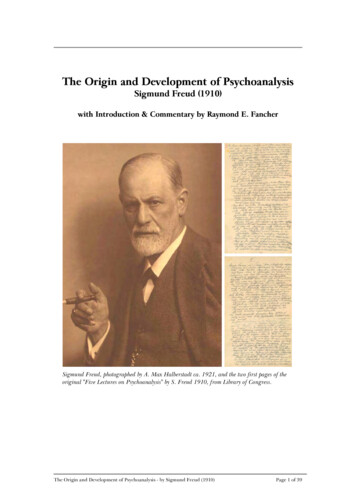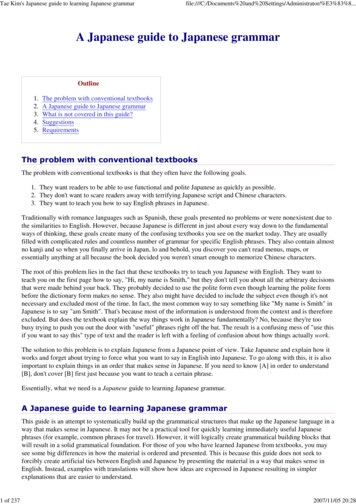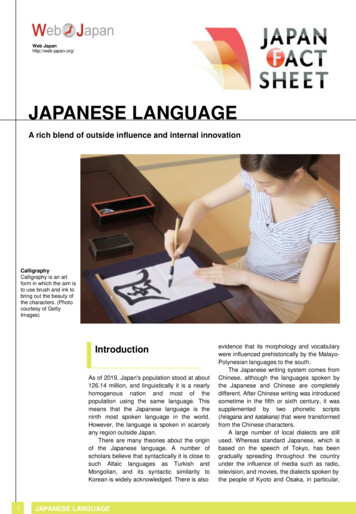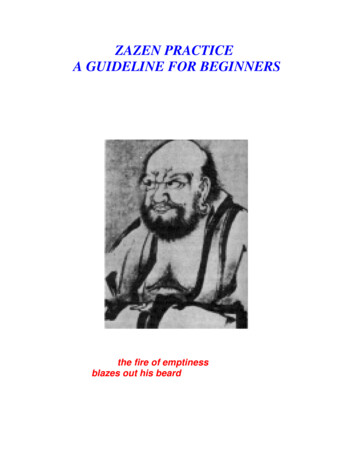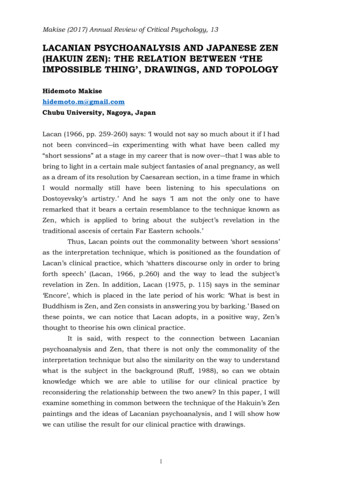
Transcription
Makise (2017) Annual Review of Critical Psychology, 13LACANIAN PSYCHOANALYSIS AND JAPANESE ZEN(HAKUIN ZEN): THE RELATION BETWEEN ‘THEIMPOSSIBLE THING’, DRAWINGS, AND TOPOLOGYHidemoto Makisehidemoto.m@gmail.comChubu University, Nagoya, JapanLacan (1966, pp. 259-260) says: ‘I would not say so much about it if I hadnot been convinced―in experimenting with what have been called my“short sessions” at a stage in my career that is now over―that I was able tobring to light in a certain male subject fantasies of anal pregnancy, as wellas a dream of its resolution by Caesarean section, in a time frame in whichI would normally still have been listening to his speculations onDostoyevsky’s artistry.’ And he says ‘I am not the only one to haveremarked that it bears a certain resemblance to the technique known asZen, which is applied to bring about the subject’s revelation in thetraditional ascesis of certain Far Eastern schools.’Thus, Lacan points out the commonality between ‘short sessions’as the interpretation technique, which is positioned as the foundation ofLacan’s clinical practice, which ‘shatters discourse only in order to bringforth speech’ (Lacan, 1966, p.260) and the way to lead the subject’srevelation in Zen. In addition, Lacan (1975, p. 115) says in the seminar‘Encore’, which is placed in the late period of his work: ‘What is best inBuddhism is Zen, and Zen consists in answering you by barking.’ Based onthese points, we can notice that Lacan adopts, in a positive way, Zen’sthought to theorise his own clinical practice.It is said, with respect to the connection between Lacanianpsychoanalysis and Zen, that there is not only the commonality of theinterpretation technique but also the similarity on the way to understandwhat is the subject in the background (Ruff, 1988), so can we obtainknowledge which we are able to utilise for our clinical practice byreconsidering the relationship between the two anew? In this paper, I willexamine something in common between the technique of the Hakuin’s Zenpaintings and the ideas of Lacanian psychoanalysis, and I will show howwe can utilise the result for our clinical practice with drawings.1
Makise (2017) Annual Review of Critical Psychology, 13Hakuin’s Zen painting and ‘the impossible thing’Hakuin Ekaku (白隠慧鶴 1685-1768) is the most extraordinary figure tohave appeared in Japanese Zen in the past five hundred years. He drewvarious types of Zen paintings. Especially, among them, the Zen paintingtitled “Pilgrimage through thirty-three places in the western region inJapan (西国巡礼図)” (see Figure 1), which could be interesting material totake into consideration for our clinical practice.Two people in the painting are pilgrims through thirty-three placesin the western region in Japan. One gets down on all fours, another onegets on the person and is writing something. It is written in the frame that“you must not scribble here (此堂にらく書きんぜい、畏入り)”. If this is aprohibition on graffiti written from the beginning by someone who isconcerned with the temple, it is unusual because the left space in theframe is too much vacant. And if this is the notification that graffiti isprohibited, the name of the management representative can be written last.If we think in this way, it will be expected that the pilgrim wrote the wholeletter in the frame. Here is the paradox of self-referentiality. What didHakuin draw such a picture for?Figure 1The clue to think about this point is covered in the inscription atthe left side of the painting, ‘the sound of the waterfall sounds (ひゝく瀧つせ)’. According to Yoshizawa (2008, p.65-66), it is said that this inscriptionmade people at that time recall the tanka (thirty-one syllabled verse) that,‘Fudaraku, where the sea beats against the shore in Mikumano, the soundof the waterfall sounds in the mountains of Nachi (補陀落や岸打つ波は三熊野の 那智のお山にひびく瀧つせ)’. That is to say, the big waterfall of Nachi isa manifestation of Kannon Bodhisattva, and the sound of the waterfall is2
Makise (2017) Annual Review of Critical Psychology, 13manifestations of infinite mercy of Kannon Bodhisattva. We might say,therefore, if one understands the meaning of this tanka, one will take apoint of view of Kannon Bodhisattva immediately.Let us return to look at the Zen painting here. The pilgrims whoscribble ‘you must not scribble here’ are in the world where they fall intothe self-denial if they mention something. If we understand the tanka, wewill look at the pilgrims in the painting with eyes of the great mercy ofKannon Bodhisattva (Yoshizawa, 2008, p.68).The two pilgrims, who live in the world of the paradox of theself-referentiality cannot perceive eyes from three dimensions outside thepainting. Similarly, we, who live in the three-dimensional world, can lessimagine the world of Buddha and Kannon Bodhisattva who are in theupper dimension as a concrete image. This relationship has a parallel inthe Buddhist view of reality; the true reality is beyond the state of having aform and not having a form. That is why Hakuin helps us notice whatcannot be said, that there is it, or there is not it, but it can be said thatthere is it certainly, the invisible thing as Kannon Bodhisattva, using theZen painting.The incompleteness of the self-referentiality and the real as ‘theimpossible thing’This kind of practice of Zen, which prompts people to aware the relationbetween people and the true reality beyond the state of having a form andnot having a form as ‘the impossible thing’ for human beings, through theproblem of the incompleteness of the self-referentiality has a deepconnection with the idea of Lacanian psychoanalysis.For example, Lacan (1991, p.434) says: ‘The one who desires assuch can say nothing about himself without abolishing himself as desiring.This is what defines the pure place of the subject qua desiring. Any attemptto explain oneself is, in this context, futile. Even a breaking off of speechcan say nothing because, as soon as the subject speaks, he is no longeranything but a beggar-he shifts to the register of demand, which is ahorse of a different colour.’When the subject becomes to be the verbal subject, the subject isdemanded to identify one signifier (S1). This means that, at the same time,the subject is excluded from himself while trying to grasp himself. Anysubject cannot identify a signifier without removing himself from the3
Makise (2017) Annual Review of Critical Psychology, 13signifier. We therefore notice that we have an illusion that there is thesubject of stating which supports the subject of statement, but in fact sucha thing has been lost somewhere through facing up to the problem of theincompleteness of the self-referentiality (Shingu, 2004, p.66).This lost thing is concerned with, however, what Freud (1900,p.184) mentions as ‘the earliest experiences of childhood’ that are ‘notobtainable any longer as such’’ in ‘The Interpretation of Dreams’, or whathe understands as the impossibility of our knowing the origins of self, andthe thing that he says the starting point of psychoanalysis is to receive it.In other words, Freud indicates that human subject comes to recognisehimself as the object of desire of the Other as language through beingconfronted with the impossibility that the human subject does not haveany signifiers to represent himself, and, for the subject, this experience iswhat we can say it is truly real. Then, he puts the foundation ofpsychoanalysis as a process of reconstructing a symbolic system in thispoint (Shingu, 2004, p.76).I think Lacan’s comment is for this reason, furthermore, Lacan(1964, p.53) points out that psychoanalysis is the place for ‘an essentialencounter-an appointment to which we are always called with a real thateludes us’. In addition, Lacan (1991, p.44) say: ‘the Gods quite certainlybelong to the real. The Gods are a mode by which the real is revealed.’These references could be related to how Hakuin tries to help the viewernotice that there is Kannon Bodhisattva in the true reality beyond the stateof having a form and not having a form, using the Zen painting. Thus, it isimportant for both Lacanian psychoanalysis and Zen that they include thequestion, how we can have the relation which supports our existencethrough the problems of the incompleteness of the self-referentiality, andthey put emphasis on looking for the way to reconstruct the subject basedon the relation to the impossibility which the question itself has.Möbius strip and ‘the impossible thing’How can we represent the state of the subject who identifies S1, or the stateof the subject who is the verbal subject? The subject becomes, asmentioned above, to be a signifier trying to grasp himself at the place of thesignifier, at the same time, the subject is excluded from the signifier. Forthis reason, the place of S1 is understood as ‘the impossibility’, theemptiness, the hole for the subject, and this place is, therefore, where it is4
Makise (2017) Annual Review of Critical Psychology, 13needed logically when the subject appears as the subject.Figure 2Lacan (1966, p.263-264) points out that the topology structured bythe function of the hole is required in order to explain the relation betweenthe subject and ‘Urverdrängung’, which is related to the fundamentalcapture of the subject by the signifier and the appearance style of thesubject. That to say, he thinks we can know that there is the pure realitythrough the topology structured by the function of the hole, Möbius strip,torus, cross-cap, by which we are given our imaginative supports to thereality.Among these kinds of topologies, Lacan regards Möbius strip (seeFigure2) as the most important. He shows that the characteristics ofMöbius strip that it has no front or back, or rather, the front is the back,the back is the front, is compared with the relation between consciousnessand unconsciousness, or love and hate, and he says that the neurotictorus is converted to Möbius strip by cutting as the interpretation(Lacan,2001). In addition, he points out that, how the subject fails to graspthe object of desire because the subject rotates around the object in thedimension of the demand is represented as the relation between thetopology structured by the function of the hole and the hole.Besed on these points, let us look at another Zen painting titled‘Hotei holding up scroll (布袋図)’(see Figure 3).5
Makise (2017) Annual Review of Critical Psychology, 13Figure 3Hotei, by twisting the two ends of the long rectangular sheet of paper he isholding up, creates a circular band with a one-sided surface, that is, it hasno front or back. Although the first part of the inscription, the six Chinesecharacters, ‘When I was in Ch’ing-chou, I made (在青州作一領)’, is shownwritten on the front side of the paper facing the viewer; the remaining ‘ashirt that weighed seven pounds (布衫重七斤)’ has been written on the backside and is seen through the paper in a reversed image. (The details showshow the words “a shirt that weighed seven pounds” would appear frombehind the scroll.) To achieve this effect Hakuin had to turn over the sheetof paper on which the painting was drawn and inscribe the words on thereverse side. He deliberately executed the work in this way in order torepresent the 180-degree turn (Yoshizawa, 2009, p.213-214). Then, whydid he do like this? It is marvellous that this circular band with a one-sidedsurface is constructed as Möbius strip.Concerned with the reason why Hakuin had perceived thecharacteristics of the Möbius strip over one hundred years earlier thanMöbius, A.F. (1790-1868) discovered it, Yoshizawa (2009, p.214) says:‘This formulation has a parallel in the Buddhist view of reality. In theoverall structure of existence as we perceive it (what is termed “mind”),being is itself nonbeing, nonbeing is itself being; illusion is itselfenlightenment, enlightenment is itself illusion. It is this reality,transcending all relative forms such as being and nonbeing, that Hakuin’spaintings attempt to convey.’ That is to say, Hakuin drew the Zen paintingwith Möbius strip, which has no front or back, or rather, the front is theback, the back is the front, to make the viewer notice that there is the truereality beyond the state of having a form and not having a form, in thesame way that he did using the Zen painting titled “Pilgrimage through 336
Makise (2017) Annual Review of Critical Psychology, 13places in the western region in Japan(西国巡礼図).Is this attitude of Hakuin the same as that of Lacan, or the attitudethat he tries to perceive the relation between the verbal subject and ‘theimpossiblity’ in the structure of Möbius strip? In fact, Lacan (2001, p.476,p.483) refers, in ‘L’etourdit’, to ‘The structure, that is the real whichappears through language’. ‘The structure is the non-spherical thingwhich is covered in verbal connections, by which the effect of the subject isgiven’.From ‘the impossible thing’ to the reconstruction of the subjectIt is not only this that, however, we can learn from the painting titled ‘Hoteiholding up scroll (布袋図). I think this painting shows us how we canovercome sufferings which we must have because we are the verbal subject,through the relation to ‘the impossible thing’.Here, let us pay attention to the words written on the sheet ofpaper which Hotei is holding up again. The words, ‘When I was inCh’ing-chou, I made a shirt that weighed seven pounds (在青州作一領 布衫重七斤)’ are the central phrase in a famous koan included in the Blue CriffRecords(碧巌録): A monk asked Chao-chou, ‘The myriad things return tothe one. Where does the one return to?’ Chao-chou said, ‘When I was inCh’ing-chou, I made a cloth shirt that weighed seven pounds’.According to Yoshizawa (2008, p.76-77), we can understand thatthe monk distinguishes between ‘the myriad’ and ‘the one’ because themonk questions, ‘The myriad things return to the one. Where does the onereturn to?’, whereas, Hakuin tries to show us that ‘the myriad’ is not ‘theone’, ‘the myriad’ is ‘the one’, that is to say, the two is the different sides ofthe same thing, everything is one, one is everything through the Zenpainting.It is interesting here that Hakuin attempts to represent the relationbetween the verbal subject and ‘the impossible thing’ with the Möbius strip,and to prompt us to reconstruct the relation between ‘the myriad’ and ‘theone’ to make us notice that being is itself nonbeing, nonbeing is itself being,that is the true Hossin (the truth of the universe). And it is said that threechildren drawn in the hole of the Möbius strip with Hotei is a symbol ofShujo (all human beings), in this respect, we can understand that therelation between Hotei and Shujo corresponds to the relation between ‘themyriad’ and ‘the one’ (Yoshizawa, 2008, p.77). Why did Hakuin express7
Makise (2017) Annual Review of Critical Psychology, 13these correspondence relations using this painting?Yoshizawa (2008, p.81) points out that Hotei in this painting is anincarnation of Hakuin. Based on this point, we could understand therelation between this painting and the viewer corresponds to the relationbetween Hakuin and the monk (or Shujo), or the analyst and the patient. Ifwe think in this way, we could think Hakuin’s true intention which is putinto this painting is tied to Lacan’s following reference closely.Lacan insists that the analyst needs to know the fact as follows inorder to be something other than simple companions to the patient in hissearch; ‘the subject’s desire is essentially desire of the Other with a capitalO. Desire can only be situated, positioned, and thus understood within afundamental alienation that is not simply tied to conflict among men, butto our relationship with language’ (Lacan, 1991, p.268). In addition, hepoints out that the analyst is required to occupy the empty place where asignifier is summoned that can exist only by cancelling out all the others,or the signifier Φ, and mentions: ‘We must know how to occupy its placeinasmuch as the subject must be able to detect the missing signifier there’(Lacan, 1991, p.268-269).It is the object of ‘Urverdrängung’ that Lacan says as the signifier Φ(Lacan, 1966, p. 579). Based on this point, we could understand that, whathe states here overlaps with the fact that he needs Möbius strip structuredby the function of the hole to explain ‘Urverdrängung’, which is related tothe fundamental capture of the subject by the signifier and the appearancestyle of the subject (the operation of the alienation). In other words, theanalyst needs to occupy the empty place like the hole of Möbius strip tomake the subject reconstruct his relationship to language summoning thesignifier Φ which gives the subject’s ties to the Other.Then, I think it is interesting that Lacan says as follows inconnection with the point mentioned above: ‘In the world of a subject whospeaks-in other words, in what we call the human world-we purely andsimply encounter a metaphorical attempt to attribute a trait in common toall objects; it is purely and simply by degree that we can try to attribute acommon feature to their diversity This is the function of the einziger Zug’(Lacan, 1991, pp. 395-396).Freud (1921, pp. 106-107) argues that, when the relation betweenthe individual and the group is forged, the symbolic identification thatstands prior to all else is mediated by the einziger Zug (a single trait) givingan example on the daughter who identified with her father by ‘coughing’.8
Makise (2017) Annual Review of Critical Psychology, 13Based on this Freud’s perspective, Lacan (1964, pp.141-142) suggests that,what is important of considering a single trait is the mathematical essenceof its ‘oneness’. In other words, he evolves this concept of a single traitdiscovered by Freud, based on the point that, what the subject becomes tobe the verbal subject, or to be woven into the Other is to count himself as“one”, and he defines the communicating passage opened by extendingconcept “one”, the cross-tie between the individual and the group, to thebeing of the individual subject as a trait unaire (unary trait), and then hepoints out the significance of making the subject reconstruct his relation tothe unary trait through the empty place in the analytical space (Shingu,2004, pp. 129-131).It should not be forgotten here is that, however, this empty place isthe place where the subject is confronted with the problem of theincompleteness of the self-referentiality and becomes to experience himselfas the object of desire for the Other, language, or where the subject graspsthe true reality through the experience. That is to say, the place where aunary trait is established, or the empty place is where the subject canreconstruct the basis of the existence of himself, which has been lost,through the relation to ‘the impossible thing’, the real. Thus, it is necessaryfor us to consider the real as ‘the impossible thing’ to position the tiesbetween the individual and the group.If we think in this way, we could understand that, what Hakuinattempts to make the subject notice the relation to ‘the impossible thing’using the Möbius strip, and, at the same time, to prompt the subject toreconstruct the relation between ‘the myriad’ and ‘the one’ is the same aswhat the analyst tries to occupy the empty place like the hole of Möbiusstrip , and to make the subject activate own desire based on the Other’sdesire summoning a unary trait which forges the relation between the ‘one’of the individual and the ‘one’ of the group. Then, in this point, we couldsuppose that this painting functions as the medium which promotes theviewer to reconstruct himself based on the transference with Hakuin in sofar as Hotei is an incarnation of Hakuin.One might say that, at this moment, the painting titled ‘Hoteiholding up scroll (布袋図)’ becomes to have significant as same as a clinicaldrawing which is created in the state that the analyst maintains to occupythe empty place, vice versa, when a clinical drawing presents the samestructure as the painting titled ‘Hotei holding up scroll (布袋図) in therelation between the analyst and a patient, the important turning point of9
Makise (2017) Annual Review of Critical Psychology, 13the analysis comes.Reading drawings which is created in the analysis as one koan (aparadox in Zen)According to Yoshizawa (2016, pp. 252-253), the Zen painting titled ‘Hoteiholding up scroll( 布 袋 図 )’ is the same structure as the koan (smallpresentations of the nature of ultimate reality, usually presented as aparadox) called Sekishuonjo (隻手音声) (the sound of the one hand) interms that the two can be represented as Möbius strip. This means thatthe painting itself has the function of the koan. Of course, we need to giveattention the fact that Hakuin had a close relationship with Kanwa Zen (看話 禅 )(meditation supplemented with koan) spontaneously because hecame to understand ascetic practice by reading ‘Zenkansakushin(Incentives for Breaking Zen Barriers)’ and he attained enlightenmentthrough a koan called ‘Joshu muji’ (a question asking whether it ispossible for a dog to have the Buddha nature or not), and that BankeiYoutaku (1622-1693) emphasised Husyou Zen (不生禅) (which just doesmeditation) taking a critical attitude toward Kanwa Zen because hethought that, to cause doubt using koan is artificial, contrary to nature(Suzuki, 1997). If we pay attention, however, to Suzuki’s reference (2011,pp. 74-75) that the important point of koan is stimulating intellectualclassification and promoting the action to the ultimate, and then pushingit suddenly down into the abyss of a ravine, we could understand that theproblem is how one can divide time when the viewer is faced with the Zenpainting, when the one uses the Zen painting as a koan like the ‘Hoteiholding up scroll (布袋図)’.If we can apply this point to our clinical practice, we might say thatwe are required to read a clinical drawing as a koan, and to cut time at themoment that the stagnation of work by a patient occurs. This way of theinterpretation has the same significance with ‘the drawing associationmethod’ (Makise, 2013, 2015). When we obtain the function of haste in thestagnation of the subject’s thinking at the moment when we punctuate thesession, the reconstruction of the subject can be done. At this moment, theanalyst is needed to maintain the empty place in the analysis.Then, how is it possible that the analyst keeps up the empty place?Lacan (1991, p.187) says: ‘The paradox of the game of analytic bridge is theabnegation which, unlike what happens in an ordinary game of bridge, is10
Makise (2017) Annual Review of Critical Psychology, 13such that the analyst must help the subject figure out what is in hispartner’s hand. In order to direct this bridge game of loser wins, in theorythe analyst should not have to make his life more complicated by having apartner. This is why it is said that the analyst as i(a) must act as a dummy’.In other words, when the analyst gives up understanding the patient andbeing the position as the one who knows how to respond to what thepatient demands, or acts as a dummy, the patient can figure out what is inhis hand, or can activate own desire based on the Other’s desire. This isalso to help the subject notice that there is a centre that is outside oflanguage in speech, and that topology structured by the function of thehole is needed to represent the structure of the subject (Lacan, 1966). Weneed to be aware of the fact that the space occupied by not understandingis the space occupied by desire when we use drawings in our clinicalpractice, I think, the Zen painting drawn by Hakuin shows the importanceof this.Observations on the clinical caseHere, we will examine how the issues mentioned above are related with aconcrete clinical case. The clinical case which we examine concerns a girlin a junior high school in Japan. Her family comprised a father, a mother,a younger sister who was two years younger than her, and the girl herself.She was diagnosed as adjustment disorders because she worried aboutbeing bullied and was not able to go to school. She was not retarded indevelopment, and I heard that she was a lively child during her elementaryschool days. When a half year passed after she began to refuse to go toschool, she went to the hospital with her mother to receive medicaltreatment.She appealed a symptom of dissociative disorder that sixpersonalities existed in herself and the personality changed when she woreglasses, in a first session. After that, she talked about the story on thebullying, the personality changes, and the story about the relation betweenhuman beings and colours; human beings each have different colours ofthat, then, if she knows the colour which the one has, she can understandwho the one is. She seemed to feel uneasy with my attitude not to show aspecial reaction toward those stories at first, she gradually came to speakabout the relation between herself, the bullying, and the personalitychanges in such an ‘asymmetric relation’ between the patient and me.11
Makise (2017) Annual Review of Critical Psychology, 13For example, she talked about the relation as follows: ‘I was livingout my days until now without thinking about anything on myself. Thatmight be not good. Because I thought that I was superior to others. It maybe that I am in the state of this now because I flattered myself’. ‘I am afraidof that I know nothing. I dislike dark places and the mysterious thingwhich I have not seen. I think that everything is scary firstly, so I try tocheck the weak point of the target in various way and grasp it’. ‘Aclassmate blamed me in various ways, and that is also the thing which Ithought it was scared, which I thought it was unintelligible. Iunderestimated her. I had branded her as such a type, that was a mistake.I was not able to understand her by preparing a manual because I thoughtthat I was superior to her’.One day, when she began to talk about own family in connectionwith herself, I prompted her to draw a ‘family drawing’. She drew fourcircles from left to right, and then, she surrounded them in a big circle (seeFigure 4).Figure 4After she had finished drawing the picture, I asked her: ‘Have you anysuggestion to make on this picture?’ She kept silent for a while as if sheholds what it is not describable in words. And then, she explained to methat the small circles are equivalent to her father, her mother, the girlherself, and her younger sister from left to right, and she said: ‘My familydoes not have thought that a father is the highest, or a younger sister is thelowest. Everyone’s opinion is adopted when we choose the food which weare going to eat, for example, yakiniku (a Japanese-style grilled meat),sushi, and so on. Everybody is equal, or everybody tries to make aconcession each other and to meet halfway’. At that I asked her: ‘Is therightmost circle slightly smaller than other circles?’ Then, she said withsurprise: ‘It is true! The four circles are not connected. I think the circle12
Makise (2017) Annual Review of Critical Psychology, 13can be separated from other circles when slightly large force is appliedeven if the four circles are connected. If four people cooperate, the power isa little stronger. The big circle is represented as a unity, a group. I wantedto express a stronger power by drawing the big circle’. It was at the pointthat I ended the session.This session became a turning point for the analysis. In the nextsession, she talked about memories when the younger sister was born, andthe fact that her position in her family changed because the younger sisterwas born, with an aggression against the younger sister, in regard to that‘the circle can be separated from other circles when slightly large power isapplied’. After that, the fact that the existence of the younger sisteroverlapped with the existence of the classmate, who was the central figureof the bullying, became clear to her. And she said that she always came todecide what she does based on what the younger sister does since theyounger sister was born, and that she carried on the life that her motherwished for until then. When two years passed after the session began, shedecided to go to the school which was different from the school where hermother went to in the past by herself at the time of examination for highschool. The symptom of adjustment disorders and the problem of truancydisappeared as a result.We will examine the significance of the clinical case that Iintroduced here in comparison with the earlier discussions. It brought abreak in the action which she continued talking about in the dimension ofdemand, that I acted as a dead (dummy) in the space of the analysis. Suchact also led deadlock to the tendency that she was going to maintain thepersonality changes or the imaginary relation to the other. And the sessionwith a ‘family drawing’ led the turning point to this development andbrought the structure of the patient’s speech a change. In other words, therightmost circle, which ‘can be separated from other circles when slightlylarge power is applied’, expresses the existence of herself, which was lostby ‘the operation of the alienation’, as well as the existence of the youngersister, and the patient’s speech came to be structured over the repetition ofthe traumatic encounter between her and language. It became clear ‘aprèscoup’ that the traumatic experience that she got bullied was alsopositioned over the repetition.That the patient looked at herself, which is supposed as what wasit at once, through the empty place of the analyst, was to look at herselfwith eyes of the Other (at this time, the patient looked at herself as ‘object13
Makise (2017) Annual Review of Critical Psychology, 13a’) or to activate her desire based on the Other’s desire. At this moment, wecould say that the relation between the rightmost circle which ‘can beseparated from other circles when slightly large power is applied’ and thebig circle was equival
revelation in Zen. In addition, Lacan (1975, p. 115) says in the seminar ‘Encore’, which is placed in the late period of his work: ‘What is best in Buddhism is Zen, and Zen consists in answering you by barking.’ Based on these points, we can notice that Lacan adopts, in a positive way, Zen
